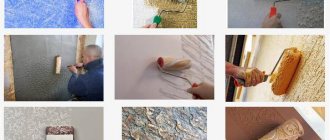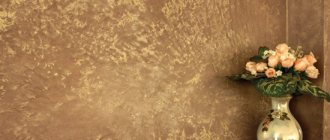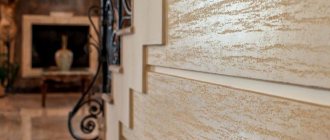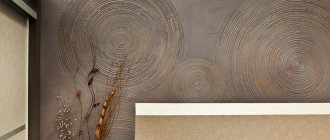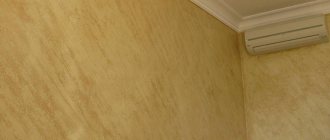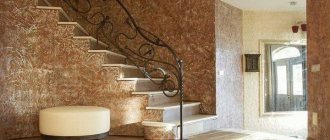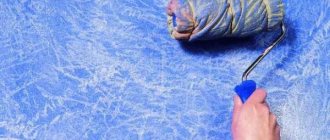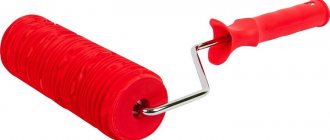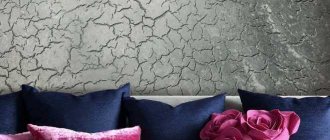Are you looking for a beautiful, safe and durable wall covering? The A-DEKOR company invites you to familiarize yourself with the current section of the catalog. Here we present to your attention a collection of interior decorative paint Perlata, the distinctive feature of which is the elusive play of color and shimmering shine. This effect was achieved due to the inclusion of pearlescent mica in the composition. Seamless “Perlata” coating is an excellent solution for people who prefer solid and at the same time sophisticated interiors!
Types of decorative plaster
Before using this method, you should understand the types of decorative plaster. The main criterion for its classification is the binder.
Finishing plaster for decorating surfaces is divided into the following types:
- Acrylic. Offered in building materials stores in the form of a ready-made mixture of paste-like consistency, the material is convenient in the process of using various technological methods for processing walls.
- Mineral. It is made on the basis of cement, is inexpensive, suitable for outdoor work, as well as for finishing rooms with high humidity, diluted with water before use in the required proportions.
- Silicone. It is made on the basis of synthetic resins, has a large number of advantages, and is a product of wide application.
- Silicate on liquid glass. Suitable for decorative finishing, it is resistant to negative factors, and has a high cost.
Decorative plaster has a composition that affects its appearance after application to the walls. There are several types of this material: structural, silk, etc. You can use Venetian mother-of-pearl plaster by studying the technology of applying it yourself.
The finish can be in the form of stone, wood, wallpaper, etc. Depending on the application technique, pearlescent plaster can imitate any type of surface. To create exclusive patterns on the walls, you need not only the materials listed below, but also artistic skill.
So, in order to finish walls with decorative plaster, you need to use a set of tools, which includes:
- trowel;
- putty knife;
- poplar;
- cuvette;
- roller;
- brush;
- sponge;
- painting tape;
- bucket.
Acrylic putty is able to dry better, and its service life is longer. The material can be adjusted within 20 minutes after it is applied to the surface.
What is Venetian plaster
Decorative plaster in the interior is considered a universal finishing material. It can be used for finishing walls and ceilings in apartments, country houses, hotels, restaurants, and offices. The Venetian fits well into designs of various styles, from contemporary loft, hi-tech and minimalism to timeless classics. The composition of such finishing mixtures consists of predominantly natural ingredients, so they are absolutely safe even when used in children's rooms.
“Venetian plaster allows you to imitate natural stone, concrete and even precious metals on surfaces (the effect is achieved by adding special pigments to the mixture."
Applying decorative plaster with a roller
The choice of structural plaster for decorating walls opens up wide scope for the expression of creativity even for beginners. There are a large number of techniques for applying such material. They can be divided into several groups:
- spray method;
- using a stencil or roller;
- using available materials.
Decorative plaster is a mandatory material. Acrylic-based wax and color are used as a finishing coating. The main tools for work are a spatula and a roller (textured or with a pile). Applying decorative plaster with the last tool is not difficult.
The solution should be prepared only when the completed primer layer has already dried. The mass of finishing material is tinted. Please note that after drying the shade may darken by 2 tones. To avoid any gaps, the primer must also be tinted first.
Apply the solution to the surface in a layer of 1-2 mm. Since the material sets very quickly, the surface area to be treated should not be more than 2 m². The applied plaster must be separated using the same lint roller. Work with it should be done in stages:
- apply the plaster with a nap roller;
- make a drawing with a textured roller;
- all movements are carried out in compliance with strict parallelism.
After applying the plaster and forming the pattern, you need to wait for 24 hours for the 1-2 mm layers to dry. Next, you should move on to creating a layer of protective coating, which can be wax. It must be applied using a medium-nap roller. It is better to use a woolen cloth to polish the surface.
Decorative mother-of-pearl plaster for interior wall decoration
To create a pearlescent effect, you can use branded decorative plaster for interior wall decoration. Modern decorative paint and plaster, with the help of which every connoisseur of exquisite interiors has the chance to transform any surface into the desired shade with a characteristic glossy shine. The imported finishing texture contains enough all the necessary components, as well as siloxane polymers and pearlescent additives. To create an original, shiny texture you will need: a sponge or brush.
Decorative pearlescent plaster designed for dry, smooth walls. The base material is a substrate - a base that must be prepared properly and applied to the required surface. After the necessary manipulations, work is carried out with the color layer. It is pre-diluted in water in a ratio of 70 to 100%. When the paint is ready, you will need an auxiliary tool. Dip the brush in paint and spread the composition evenly over the surface. During the process, make sure that the pearlescent paint does not dry out. At the same time, perform the final cladding, achieving a wavy texture. If using a sponge, use a light stamping motion.
Decorative mother-of-pearl coatings
Mother-of-pearl decorative wall coverings can be purchased in our showroom in Moscow and St. Petersburg; we tried to collect all the imitation mother-of-pearl in one place, which is in steady demand and gives a variety of surfaces a pronounced mother-of-pearl effect.
· Decorative paint with mother-of-pearl. The composition is prepared for use, and the advantages are that there is no need to achieve the desired consistency.
· Pearlescent paste. It is diluted in paintwork materials in adjusted proportions and stirred until a homogeneous mass is obtained. The finished component can be used for all kinds of styles.
· Powder. It is poured into acrylic coatings in compliance with a certain quantitative ratio.
All acrylic paints for walls with the addition of pigment and mother-of-pearl are highly resistant to external influences and have a long service life.
Pearlescent decorative paint with a silk effect can well paint concrete, wood, drywall, glass, and metal. Auxiliary pigments do not in any way affect the properties of the main paint and varnish material, therefore this composition is often used as protective coatings for walls from rotting and other negative processes. As for decoration, decorative coatings can be positioned from two points of view: highly saturated, slightly saturated consistency. The first option is not advisable to use entirely in residential premises, since too much shine will tire the eyes. Decorative pearlescent paint is great for highlighting any individual interior items. But a desaturated shade, on the contrary, will delight and attract the eye.
Decorative paint with mother-of-pearl: application in the interior
If decorative paint with mother-of-pearl does not suit you, then the pearlescent effect can be achieved using plaster mixtures, which contain various fillers that give the walls a characteristic gloss and deep shimmer. The most common example of using similar solutions is Venetian. Decorating surfaces with wonderful decor will allow you to achieve the desired shade. This coloring looks most advantageous in daylight or artificial lighting, when the advantage of the play of light and shadow is clearly expressed. However, such a delightful effect is only possible when decorative coatings are applied in multiple layers.
Warm pearlescent paint and shades in combination with other tones, which can be achieved using modern plasters, benefit from a soft, pleasant shine. Such decorative finishing is used more and more often in the interior of residential premises. A good example is Golden Autumn. The iconic accent is aimed at the successful combination of golden color and mother-of-pearl. The main leitmotif of imported decorative and domestic paint is the harmonious play of pearlescent pigment with bronze, gold, silver and other colors.
Now we can conclude that a pleasant pearly shine when decorating walls and ceilings is achieved using special pigments based on plasters or acrylic paints. Any mother-of-pearl mixture has its advantages and disadvantages, but no matter what you choose, our showroom in Moscow, St. Petersburg and the online store of decorative coatings will always offer only high-quality finishing materials for true connoisseurs of exquisite interiors.
How to prepare walls
The walls should be prepared in the same way as for painting. The surfaces should not have any defects. All dents and bumps must be removed promptly. A thorough inspection should be carried out over the entire plane, also examining the internal corners, which should not contain plaster deposits. 1 hour before applying the putty, the wall surface must be primed with latex primer.
The texture should be applied from the corner, but finishing in the middle of the overlap is not recommended. It is better to continue after a few hours or the next day. The putty must be mixed until smooth. You can apply the mixture onto the trowel using a spatula.
After covering with a layer of putty, plastic film should be laid out on the wall. The area of the material must be larger than the dimensions of the overlap. It is recommended to lay out polyethylene from the corner. It does not need to be smoothed, since the relief texture can be obtained with the film as crumpled as possible. You should apply the material with a partner, since someone must fix it on the wall, and the other must hold it from the free edge.
After covering the wall with film for ⅓ of the entire area of the polyethylene fold, it is necessary to tighten and twist it, forming patterns of an arbitrary nature. In a day you can decorate 2 walls that do not have a common corner. This will preserve the outline of the design in the adjacent corners.
The polyethylene is removed after 12-15 hours, when the putty on each wall has already dried. The evaporation of moisture under the film occurs very slowly, so soft areas may remain on the walls. If they are present, the walls can be dried without film for 24 hours.
Advantages
Of course, no material is perfect, but this wall covering really has no obvious drawbacks, although some skeptics will naturally point out that the cost of Venetian plaster is quite high.
But, as admirers will note, this is quite understandable and justified, especially taking into account the unique appearance and, most importantly, the high performance characteristics, as well as the durability of this decorative plaster.
So, the indisputable “advantages” of Venetian plaster should be considered:
- environmental friendliness of the material - since natural ingredients are used, it is completely safe for humans;
- strength;
- resistance to temperature changes - such a coating can be used at thermometer values from -20 °C to +50 °C;
- vapor permeability;
- The moisture and water resistance of the coating is the reason that Venetian plaster in a bathroom or swimming pool is often used to finish wall surfaces or to design individual decorative elements of the interior;
- the service life of Venetian decorative plaster is at least 15-20 years;
- hygiene;
- ease of care;
- biological inertia, due to which the spread of mold in a room, even with very high humidity and temperature changes, does not threaten the walls;
- resistance to many aggressive, including chemical, environments.
You should also take into account the wide variety of types of textures, colors, and the possibility of creating a pattern on the walls. In this regard, even wallpapers, which are distinguished by great decorative diversity, are losing ground.
In this video you will be introduced to the secrets of applying decorative Venetian plaster.
Technique for applying mother-of-pearl
To dilute the pigmented wax of the desired shade, warm water is used, the volume of which is ⅕ part of the total amount of prepared wax. The composition should be applied to the wall using a bath sponge or roller. When the coloring material has already been laid out, a clean sponge or roller is used to remove any excess.
The wall must be rubbed with a damp sponge so that it acquires a uniform pattern. To remove dark spots of paint in the corners, wrap a spatula in a rag and then rub the paint with it. The finished surface must be treated using a clean white rag. Then you will need to wait 4 hours until it dries completely.
Acrylic pearlescent paint is diluted with water. It should contain 40% of the total volume of the dye. To apply mother-of-pearl to the wall, use a clean sponge. When the surface is ready, the masking tape can be removed. As a result, you will be able to obtain a textured surface that can perfectly reflect light.
Pearlescent pigment is sold in the market in the form of powder or paste. You can also purchase ready-made enamel with a pearlescent tint. The acrylic composition of this substance becomes more stable after drying and does not require additional protection.
When using pearlescent dye in powder form, the shade can be easily adjusted. It is permissible to dilute mother-of-pearl in the form of a paste with acrylic enamel. Thus, there are a great variety of options for applying decorative plaster with mother-of-pearl.
Decorative mother-of-pearl paint: originality of decoration
The pearlescent effect in a non-uniform decorating process can be achieved using special decorative paint or plaster with fillers and coloring agents. Of course, you need to choose one of the listed options in advance, unless you have a strong desire to apply both methods to the walls of the entire apartment. Painting and plastering include a variety of methods and techniques for achieving a pearlescent sheen, so it makes sense to first consider finishing surfaces with paints and varnishes.
The magnificent pearl effect, brightness and color saturation is achieved through powder pigment, an auxiliary component used in wall decoration. The illusion of mother-of-pearl can be observed when the sun's rays hit the facing surface and are slightly refracted. The degree of play of light depends on the percentage of dye in the decorative coating. It is decorative pearlescent paint that, as a rule, is diluted with the exception of prepared solutions.
Application methods and technologies
The main classical methods and technologies for applying decorative Venetian plaster have remained unchanged for centuries, and among them the most popular and well-known are the following.
Carrara
Carrara is one of the most expensive options, as it uses very rare and expensive Carrara marble, which is distinguished by a rich palette of colors. With the skillful application of a large number of layers (the number of which can reach 12), it is possible to create a uniquely beautiful coating that plays in the sun with a variety of colors.
The main distinguishing feature of this option, in addition to the large number of layers, is that each of them differs from the previous one both in color and application technique.
But since real Carrara uses crumbs from expensive and very rare Carrara marble, its imitation is often used using colored fillers to glaze the surface, and in the end the effect is achieved through bright accent spots.
Venetian plaster Carrara marble
Craquelure
Craquelure - allows you to artificially age the coating by simulating cracks on the surface. This is achieved by using a special varnish at the final stage (it’s called “craquelure”), which, gradually hardening, has the ability to “pull” the top layer of plaster behind it, breaking it.
Craquelure technique on Venetian plaster
Thus, cracks of artificial origin are formed, however, the presence of which on the surface of the walls does not have negative consequences for operational characteristics.
The most expensive item when creating this coating is the purchase of varnish, so the craftsmen have come up with a way to reduce its cost. To do this, after applying the next layer, the wall surface is forcibly dried, for example, with an infrared emitter, which leads to the formation of cracks.
In this case, it is enough to heat only until they begin to appear - then they spread on their own. Then a dark plaster composition, usually tinted with soot or red lead, is rubbed in, and an additional colorless layer is applied on top.
The final design is achieved using wax, which covers the treated wall surface. You can see the result of this work in the following video.
Marseille wax
Venetian decorative plaster owes its high moisture resistance to “Marseille wax”, which was directly added to the mixture.
The French were the first to figure out how to protect the coating from moisture, using cellulose fibers ground and boiled in wax.
Relief plaster using wax
Vein effect
The effect of veins on the surface of Venetian plaster is achieved by using bituminous marble chips tinted with soot. In this case, to apply smears, you should use a very thin instrument, for example, a medical spatula, and then thoroughly rub the applied layer.
The next layer of plaster is applied evenly over the entire surface, and tinting is not allowed.
Venetian plaster with veins
In this video tutorial you will be told about applying Venetian plaster with a marble pattern and veining.
